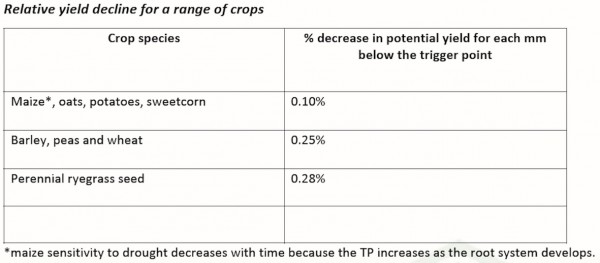As the soil dries from the trigger point (TP) toward wilting point, potential yield decreases in a straight line.
The slope of this line describes the relative yield decline (RYD).The bigger the potential yields, the greater the relative reductions in yield after TP. The rate of yield loss has been assessed for a range of crops and is described as a percentage of potential yield per mm of soil water deficit (SWD) above the TP.

The form of yield loss can change. For instance, early drought stress in barley reduces grain number mostly through the loss of tillers, whereas late drought stress results in small, pinched grain with high screening losses.
The yield response to irrigation is the result of avoiding a situation in which the trigger point is exceeded. In round terms, a 50 mm irrigation on a very healthy wheat crop (potential yield 13 t/ha) applied just before trigger point is reached is 13 t/ha x 50 mm x 0.25% = 1.63 t/ha. Assuming irrigation costs $100/ha ($2/mm/ha) and the wheat is worth $300/t, the return would be $480/ha, a net gain of $380/ha.
For the same irrigation on a 2.5 t/ha ryegrass seed crop, the yield response would be 2.5 t/ha x 50 mm x 0.28% = 0.35 t/ha. At a value of $2,500/t, the return would be $875/ha, and return net to irrigation of $775/ha. In this example, if there was insufficient water it would pay to irrigate the perennial ryegrass ahead of the wheat.
If the soil water content is below the trigger point and there are two warm summer days (equivalent to ET of 10 mm) there will be a potential yield loss of 1 to 3% depending on plant species.



 Classifieds
Classifieds

